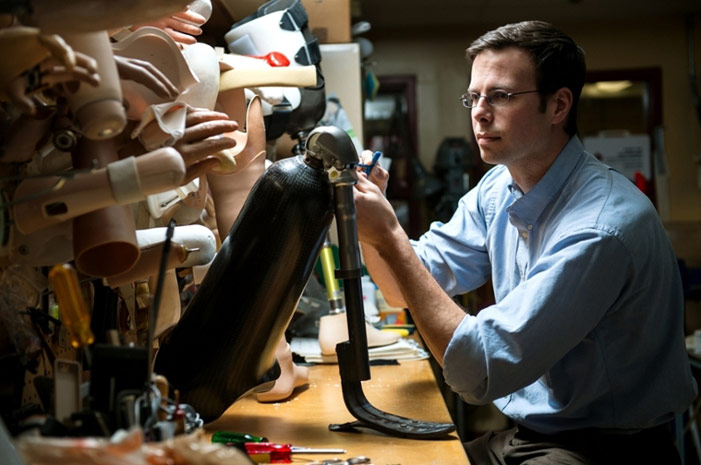UNB bionics expert named 2016 Young Health Researcher of the Year
Author: Communications
Posted on Dec 28, 2016
Category: UNB Saint John , UNB Fredericton

For Jon Sensinger, associate director of University of New Brunswick’s Institute of Biomedical Engineering, a childhood dream has turned into an innovative career – one that is changing lives across the globe.
A pioneer in the field of biomedical engineering, Dr. Sensinger was recently named 2016 Young Health Researcher of the Year by the New Brunswick Health Research Foundation (NBHRF) after careful consideration from a national peer review committee.
“To have my work recognized by the peer review committee amongst this collection of outstanding health researchers is an honour,” he says.
The foundation highlights top researchers in the province throughout the year by selecting them as Researcher of the Month. Those honorees are then considered for Researcher of the Year, presented at the annual New Brunswick Health Research Conference.
“NBHRF supports excellence in biomedical, clinical and overall fields of health research,” says Bruno Battistini, CEO of NBHRF. “For the past four years, NBHRF selected the best health researchers, young and senior investigators, clinicians, the best in their fields from around New Brunswick and presented their profile and expertise to the entire province so that all can relate that the best of health research leads to better healthcare.”
“For this 2016 edition, the independent pan-Canadian seven peer-review members of the committee selected Dr. Sensinger as the best of 16 pre-selected young health researchers across New Brunswick, as our representation of excellence, the Young Health Research of the Year recipient, and we are proud of him, and for him to be one of our own.”
Dr. Sensinger came to UNB more than four years ago from the Rehabilitation Institute of Chicago, where he was director of the Prosthesis Design and Control Laboratory.
“Jon has been a tremendous presence at the Institute of Biomedical Engineering here at UNB since arriving in the fall of 2013,” says the institute’s director, Kevin Englehart. “The standards he sets in terms of the quality of his work has been an inspiration to his students, and his colleagues.
“He collaborates easily with colleagues at UNB and around the world, which has broadened the scope of activities at our institute leading to research in exciting new directions. He is also deeply engaged in the clinical activities of our limb-fitting centre, which serves to guide and underscore the impact of his work.”
Dr. Sensinger’s research focuses on understanding how the human brain can work in tandem with the control interfaces created to operate a prosthesis – in other words, finding ways to develop thought-controlled bionic limbs.
Because a bionic limb has fewer sensors than a real arm, the brain relies heavily on clues the eyes send back in order to plot movement. That’s fine for the big picture and broad movement but more intricate agility requires more sensors. It’s imperative to examine what other types of sensors can be used to successfully communicate with the brain to improve how artificial limbs work.
Dr. Sensinger is currently developing technology that provides audio feedback, producing a tone with each joint movement. Recent studies suggest that this new technology is improving performance.
His research also includes the burgeoning field of exoskeletons – powered orthoses used for amputated lower limbs, spinal cord injuries or complications due to stroke. Reliability, safety and the ability to walk as normally as possible are imperative.
“I’ve wanted to do exactly what I’m doing since Grade 7,” says Dr. Sensinger.
Seeing children in his classroom struggle with physical disabilities, he was inspired to find a way to help. His teacher first told him about the field of prosthetics and with encouragement from engineers at a local prosthesis shop, he pursued a PhD in biomedical engineering.
Dr. Sensinger believes that the Internet of Things will play an increasing role in the future of the field of prosthetics. The data from wearable technology, like smart watches and Fitbits, could be used to figure out what sensory feedback to provide or as part of a control strategy for walking.
“I really see this being an area where we can leverage the consumer industry to improve healthcare,” he says.
